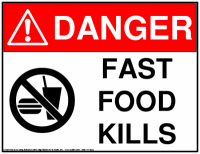Three Common Industrial Chemicals in Fast Food

(NaturalNews) Many people think occasional junk food indulgence can be balanced out by skipping meals later in the week or by putting in some extra time on the treadmill. The truth is that the consequences of this type of eating can turn up in unexpected ways, often years later as toxins accumulate in your body and cause serious illnesses like cancer or diabetes.
It is only in the past several decades that the abundance of toxic chemical ingredients in food, have made the consequences of dietary indulgences so lethal. In order to boost profits, food purveyors use chemicals which have a similar effect to the tobacco industry’s addition of nicotine to tobacco, making a substance at once more addictive and more deadly.
Mystery Ingredient #1
Take this quiz to help you to see how much you know about the real results of fast food snacking: What was concocted in a laboratory in 1908 and is present in nearly every non-dessert item on KFC’s menu?
What “seasoning” did the US begin manufacturing subsequent to WWII after learning that rations for soldiers on the opposing side included this substance?
When the FDA “generally regarded as safe” (GRAS) standard for food additives was established in 1958, what substance was grandfathered in without any testing to verify its safety?
What food additive, so omnipresent in fast food restaurants that even salads often contain it, has been linked to obesity as well as depression, migraines, mental confusion, dizziness, anxiety or panic attacks, stiffness, joint pain, loss of balance, slurred speech, diarrhea, blurred vision and ADHD?
What chemical substance do food manufacturers love to use so much that they have developed a long list of aliases to hide its presence from consumers?
If you answered MSG to all of the above questions, give yourself a gold star for knowledge of food chemicals.
Mystery Ingredient #2
What popular sweetener, present in most soft drinks and “sports drinks,” is manufactured via a process which makes use of glutaraldehyde, an embalming chemical?
What sweet-tasting ingredient, found in such diverse products as McDonald’s Baked Hot Apple Pies, children’s vitamins and commercially prepared salad dressings is frequently contaminated with mercury because of the method by which is it prepared in factories?
What food additive delivers calories yet chemically fails to satisfy hunger, causing people to eat more than necessary? Because this substance does not stimulate insulin secretion or reduce the hunger hormone ghrelin, people continue to eat while the body converts what they consume into fat.
If you know the answer to the above 3 questions is high fructose corn syrup (HCFS), you are well-informed. This is a challenging accomplishment considering how much disinformation the food manufacturers, the government and the mainstream health establishment put out about HCFS being harmless. Beware, however, because the food industry has been mulling a name change for this ingredient, possibly calling it “corn sugar” or some new brand name so they can continue to take advantage of subsidized US corn.
Mystery Ingredient #3
Which of the following fast foods does NOT contain dimethylpolysiloxane, an anti-foaming agent also used in caulks and sealants and Silly Putty:
a) McDonald’s Chicken McNuggets
b) McDonald’s Fish Filet Patty
c) Wendy’s Natural Cut Fries
d) KFC BBQ Baked Beans
e) KFC Biscuit
f) None of the above
The correct answer is “f” none of the above. (Chances are if your child swallowed some caulk, you would rush to the emergency room. Perhaps people should start doing the same if their children consume fast food.)
interesting post – looks like heathy is back in fashion…!
good to hear it’s not too trivial…